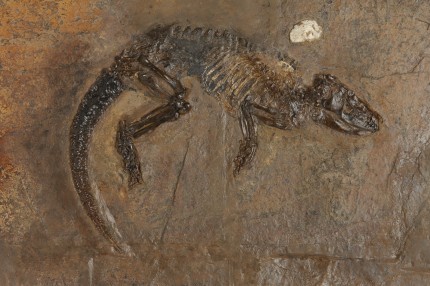July 4th, 2009, was one of six digs a year the Hessian State Museum holds on Saturdays with members of the local amateur paleontology organization at the Messel Pit, the former shale quarry 22 miles southeast of Frankfurt that was declared a UNESCO World Heritage site for its exceptional deposits of early mammal fossils from the Eocene Age (57 million – 36 million years ago). One of the volunteers digging through layers of brittle oil shale was Klaus-Dieter Weiss, chairman of the organization who has been an avid fossil enthusiasts ever since someone gave him a petrified fish 40 years ago when he was 15. Weiss pushed a shale plate aside and saw a scaly tail.
 It belonged to a virtually complete and beautifully preserved Pholidocercus hassiacus, a small insectivorous mammal related to modern hedgehogs that lived 47 million years ago. It had spiny fur like a hedgehog, and a long, thick rat-like tail covered in scales. The top of his head was also scaled, giving him a sort of helmet. This is only the seventh Pholidocercus ever discovered, and it’s one of the most complete.
It belonged to a virtually complete and beautifully preserved Pholidocercus hassiacus, a small insectivorous mammal related to modern hedgehogs that lived 47 million years ago. It had spiny fur like a hedgehog, and a long, thick rat-like tail covered in scales. The top of his head was also scaled, giving him a sort of helmet. This is only the seventh Pholidocercus ever discovered, and it’s one of the most complete.
Dr Norbert Micklich, from the Hessien State Museum in Darmstadt which has a huge collection of fossils from the Messel Pit, told The Local the find was extraordinary.
“You can see the shapes of the animal’s hairs – by the fossilised bacteria left there,” he said. “If we can take samples from what looks like the remains of the gut and get them under an electron microscope, we could even be able to work out what it had been eating.”
This high level of preservation is due to the unique environment of the Messel Pit. It was a lake bed during the Eocene, part of a series of lakes in the middle of sub-tropical forests. The bottom of the lake was relatively undisturbed by currents, and as layers of mud and vegetation sank, they created a highly anoxic environment uncongenial to aquatic animal life. With little movement, little oxygen and a slow rate of deposition, animals and plants that died in the upper layers of the lake were preserved in amazingly pristine layers. That’s how you get details like the shape of hairs and the stomach contents of an animal’s whose last meal took place 47 million years ago.
Another Pholidocercus hassiacus found in the Messel Pit and now in the Hessian State Museum is the holotype of the species, the specimen used to determine the scientific classification of the animal, but it’s missing half of its tail. This one’s tail is perfect. There is a piece missing from its spine, however, and according to the museum’s press release, that missing piece caused something of a paleontological drama.
The excavators didn’t notice a missing part; they thought the fossil was complete when they packed it up and sent it to the museum. When researchers unpacked it they got a nasty surprise. What caused the flaw in the center spine? Was it damaged in packing or in transit? Was it deliberate sabotage? The pictures taken in situ weren’t helpful. They were either lost, unusable or the key area was obscured by shadows.
Finally modern image processing technology revealed that in fact the damage had been done before the fossil was discovered. The plate was inadvertently split when the layers above it were being broken up, but the crack was hidden from sight by fine shale gravel. In the excitement of discovery, nobody noticed the flaw. The missing part has now been reconstructed.
The discovery was just announced at the end of February. The intervening three years have been dedicated to fully excavating the fossil from the shale, preserving it in plastic and repairing the spine. It was time well spent. Look at this beauty:

I can’t get over the scales on the tail. It’s like Japanese armour.